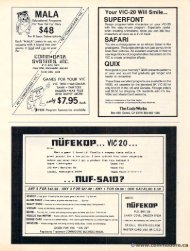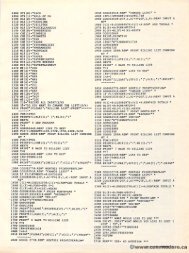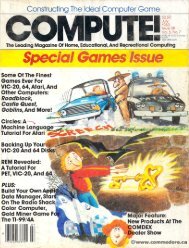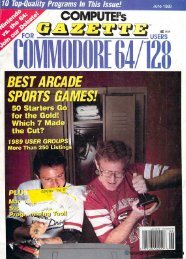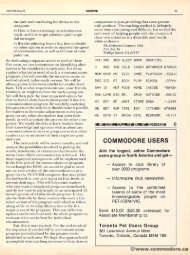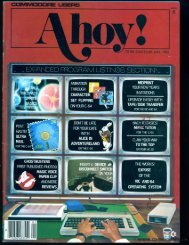May June 1980 - Commodore Computers
May June 1980 - Commodore Computers
May June 1980 - Commodore Computers
You also want an ePaper? Increase the reach of your titles
YUMPU automatically turns print PDFs into web optimized ePapers that Google loves.
112 COMPUU. MAVIJUNE . <strong>1980</strong>. ISSUE 4.<br />
112 COMPUTE. MAY/JUNE. 198O ISSUE &.<br />
50 to start outputting MARKS, pokes the lower case<br />
mode for PET screen output, and then calls 52<br />
50 to start outputting MARKS, pokes the lower case<br />
mode for PET screen output, and then calls 52<br />
for the prompt to to check that your cassette is is running<br />
and 54 to initialize variables and the details of<br />
and 54 to initialize variables and the details of<br />
paper size and format that you wish to to use.<br />
71 simply outputs the current S$, then carriage<br />
returns and, if if required, linefeeds to the next page.<br />
80 cleans up: linefeed to to a blank page so that<br />
garbage created by turning off the audio doesn't<br />
spoil the beautiful page that Cheep Print has just<br />
produced, then ding the bell on the printer to announce<br />
that it's done, followed ed by a wait loop for a little<br />
trailer on the tape. Then the shift register at 59467<br />
is reset so that the PET tape read and write will<br />
operate properly and the graphics mode for screen<br />
operate properly and the graphics mode for screen<br />
output is is restored.<br />
98 converts the hex string Q(uery)$ into the<br />
equivalent number A(nswcr). A(nswer).<br />
99 loads (hex machine) C(ode)$ into memory<br />
locations beginning at MA.<br />
Lines 5 and 6 serve only as an index to the<br />
program lines that structure Cheep Print for the<br />
printer you use. I have included the most common<br />
options in the listing.<br />
Line 23: : with the REM, we list the program<br />
with extra space for comments. Delete the REM, and<br />
the program is listed single spaced, with the print<br />
output strung across the whole page. This is useful<br />
during development; not only does it execute more<br />
quickly, but it is an advantage to have as much as<br />
possible of the program in view at once, provided<br />
that the details of what is supposed to happen are<br />
fresh in your mind.<br />
Lines 50 and 63-66 are involved in setting the<br />
baud rate and whether originate or answer mode. In<br />
line 50, only the mode needs to be determined, and the<br />
two possible choices are snuck in following the REM.<br />
Lines 63-66 contain that portion of the machine code<br />
which depends upon the baud rate and the mode.<br />
The four options given are receive and originate<br />
mode at 110 and 300 baud (10 and 30 characters<br />
per second), and which one you use is determined<br />
by which of the initial REM's isn't there. Table 2<br />
gives the details of getting output at different<br />
frequencies and baud rates. The timing parameters<br />
MF and SF determine the mark frequency and the<br />
space frequency appropriately for you to be in<br />
originate or answer mode; the decimal equivalent of<br />
MF also needs to be reflected in the initialization at<br />
line 50. Usually you will want to be in answer<br />
mode when talking to a terminal and in originate<br />
mode when talking to a mainframe. The baud rate is<br />
determined by the timing loop parameters XR and<br />
YR, and the duration of the stop bits by SB. I did<br />
some experimenting with these parameters and found<br />
that the baud rate could be off by 7 or 8 percent<br />
and the mark and space frequencies off by 4 percent<br />
and still get solid copy; SB only needs to to be<br />
sufficiently long. The output can be structured in in<br />
any way you wish, of course; for instance, you<br />
could generate tapes to Kansas City standards if if you<br />
wish. The most important thing is is that your cassette<br />
recorder should run at the same speed at home as<br />
it it does at your printer, but it it doesn't matter what<br />
the speed is. If you are forced to use battery<br />
operation at your printer, then you should use<br />
battery operation at home or else experiment with<br />
the timing parameters to compensate for the speed<br />
difference that many recorders exhibit between battery<br />
and a nd AC line operation.<br />
.<br />
Lines 85-86 contain the formatting data for the<br />
two styles of listing, and lines 87-88 contain two<br />
types of carriage return- line feed sequences. These<br />
are implemented by LISTing 85-88 on the screen,<br />
deleting the line number and REM from the data<br />
you wish to use, usc, and then hitting RETURN;<br />
the PET screen editor picks up the line number<br />
55 or 56 that remains and inserts these statements<br />
into the program. Lines 85-88 remain unchanged for<br />
future use. The carriage return-line feed sequence<br />
that you need will depend on the printer you use. I've<br />
used a DECwriter and a thermal printer in which<br />
carriage return (Control-M) does not also give a<br />
line feed (Control-J), and a Selectric which includes<br />
the line feed with the carriage return whether you<br />
like it or not. Further, the DECwriter requires no<br />
nulls to waste time while the print head returns to<br />
the left side of the paper, the thermal printer sometimes<br />
requires as many as four nulls, and the Selectric<br />
wants a goodly number of nulls. The Anderson<br />
Anderson-<br />
Jackson Selectric has an 800 character buffer to<br />
deal with transmission faster than the print mechanism<br />
can keep up with, and the nulls plus the program<br />
execution time seem to be enough to keep the buffer<br />
from overflowing. If you have a Selectric, one solution<br />
is to make every other character a null, , which is<br />
included in the REM of line 8; if you use these<br />
nulls, declarations of P will have to go inside the<br />
FOR-NEXT loops of lines 44, 47, 53, , 22, and 17. . I<br />
doubt that the line 8 nulls are a good solution for<br />
a Selectric, because there is a mechanical clutch<br />
that continually engages and disengages, and probably<br />
wears more than it needs to. . This clutch is also the<br />
reason that the listing output is generated line by<br />
line, rather than simply printing individual characters<br />
when ready; ;<br />
As an example of using Cheep Print to serve a<br />
host program, I wrote a quick 6502 disassembler in<br />
Basic so that Cheep Print could list its own machine<br />
code for commenting. The disassembler isn't included<br />
here because there's nothing particularly exciting or<br />
instructive about it. The disassembly shows that the<br />
machine code is only a simple software timing loop,<br />
performed with interrupts inhibited (this is important!)<br />
so that the timing doesn't get messed up. The<br />
machine code outputs the start bit, and then the<br />
contents of memory location 1023/03FF low order bit<br />
first. All the printers I know ignore the highest



